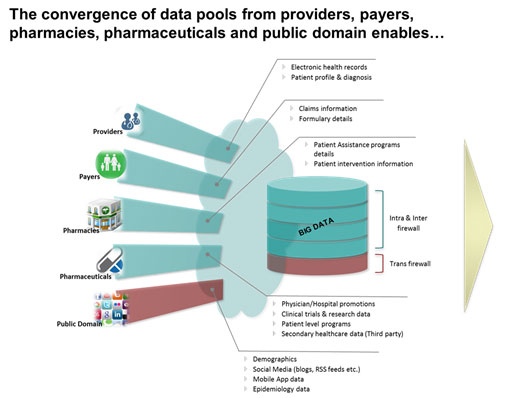Applying big data analytics to improve patient-centric care
Sumit Prasad, Manager, Mu Sigma
7 January 2015
The changing economic, regulatory, technological and healthcare environment has given rise to a strategic shift from product and physician-centric strategies to a ‘patient centric’ approach, reflecting how healthcare decision-making has changed in recent years.
In a recent report, Thomson Reuters highlighted that in the pharmaceutical sector, after drug discovery and market knowledge, understanding the patient better is set to be the next big opportunity for big data analytics.
Patients are no longer just passive players in the healthcare system. They are becoming more knowledgeable about their conditions and the medical options available to them, and are taking greater control of their own treatment. This process of empowerment has led to patients developing their own brand and product preferences, and presents pharmaceutical companies with a new audience to cater for. In order to achieve a high level of patient centricity, understanding patients’ needs is fundamental, and this can only be achieved by ‘deep-diving’ into ever-growing amounts of patient data.
The importance of patient centricity
Patient centricity focuses on the understanding of patients’ needs in the context of the state of their condition and experiences within the healthcare system. This means putting the patient at the heart of every business decision in order to develop and provide solutions based on an in-depth, all-round knowledge of the patient.
To implement a truly patient-centric model, it is crucial to understand the complex journey through the healthcare system and explore how patients’ experiences at each stage of this journey can be enhanced. Making this concept a reality is not as hard as it may sound. Every patient interaction generates reams of structured and unstructured data.
With the right combination of big data tools, skills and platforms, pharmaceutical companies can harness this data and generate actionable insights. In turn, these will go a long ways towards identifying patient preferences and formulating future strategies.

Who are the beneficiaries?
Provider networks are one of the biggest and best sources for capturing and collating large volumes of healthcare data. The information captured ranges from structured data around patient schedules, billing, prescriptions and hospital records to unstructured information from health monitoring equipment, medical transcripts and customer feedback. Adding to this is an ever-increasing flow of social media data as patients increasingly share experiences of their conditions, treatment or views on medicines.
Gathering patient insights and using them across various functions, such as R&D, the supply chain, medical affairs and commercial functions, is a powerful way to make business decisions. All stakeholders stand to gain from this approach: payers can apply the insights to reduce costs, care providers can improve service quality by addressing previously hidden issues, and pharmaceutical companies stand to gain by increasing revenues.
Needless to say, all these processes need to adhere to the Data Protection Act and ensure patient privacy and data is carefully protected.
Role of pharmaceutical companies in paving the way
Collaboration with all stakeholders is critical in order to find different ways to engage patients on their journey.
Strictly speaking, the patient has no need to interact directly with a pharmaceutical company. Therefore pharma firms first need to grasp what will get patients to do so, and then find creative ways to engage them — by offering a value-add over what they get from their doctor or pharmacy.
In tactical terms, this could be a specialist online forum, where patients get access to international experts on their condition, or setting up a Facebook page so patients can exchange experiences or organise meet-ups with fellow sufferers.
To grow into this new role within the healthcare system, pharmaceutical companies need to overcome established mindsets and cultural barriers, and move away from their physician and brand focused business models of old.
However, patient centricity is not about pharma firms taking away from the healthcare system, but complementing it by enhancing patients’ lives with their condition. Ultimately, the result of any patient-centric strategy has to be an improved patient experience and better health outcomes, which will help the pharmaceutical company differentiate its own offerings against those of competitors.
Sumit Prasad, Manager, Mu Sigma www.mu-sigma.com
See also:
The barriers to tapping into Big Content and how to overcome them
How big data is being used in healthcare today
Protecting critical healthcare data in the era of 'big data'